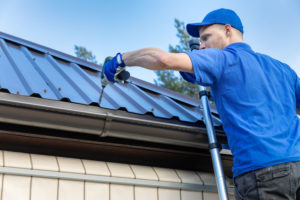A cool roof isn’t just “cool,” — it actually helps your home stay cool inside. Destin Roofing is here to help you know more about cool roofs, and saving energy in your home.
A cool roof is a roof that reflects more sunlight and absorb less heat than a standard roof. A cool roof can use reflective paint, a sheet covering, or reflective shingles or tiles to deflect heat from the sun, baking down on your roof. Before deciding to get a cool roof, consider the climate or environment in which the building is. Standard roofs can reach 150 degrees Fahrenheit or more under the summer sun. A cool roof, on the other hand, can reach up to 50 degrees Fahrenheit less than the standard roof.

Why a Cool Roof?
There are many ways you can enjoy having a cool roof on your house.
- Reduced energy bills by easing the strain on your AC system!
- Increased comfort for spaces of the house that don’t have air conditioning.
- Decreasing the temperature of the roof, which may extend the roof service life.
Cool roofs don’t just benefit you – they are also better for the environment!
- Help reduce local air temperatures.
- Lowers peak energy demand.
- Help reduce power plant emissions by reducing cooling energy use in buildings.
Considering a Cool Roof?
Before choosing to install a cool roof, there are things to consider.
- Will the cost justify the energy savings?
- How well insulated your current roof is and the type of roof you have.
- The efficiency of your heating and cooling system.
Types of Cool Roofs
Low Sloped Roofs
Single-ply membranes have prefabricated sheets rolled onto the roof and attached with mechanical fasteners. They adhere with chemical adhesives or are held in place with ballast. They can be cool by adding reformulate or coating the black membranes to make them reflective.
Built-up roofs consist of a base sheet, fabric reinforcement layers, and a dark protective surface layer. There are many ways to make built-up roofs cool. One way is to substitute reflective marble chips or gray slag for dark gravel in a flood coat of asphalt. Use reflective mineral granules or a factory-applied coating to make your roof cool. Or cool coating on top of a dark asphaltic emulsion coating.
Modified bitumen sheet membranes have layers of plastic or rubber material with reinforced fabrics and use mineral granules or a smooth finish. Modified bitumen sheet membranes can be cool by adding a pre-coat with a cool roofing coating at the factory.
Spray polyurethane foam roofs consist of mixing two liquid chemicals together. Those chemicals react and expand to form one solid piece that adheres to the roof. It is important to remember that foams are susceptible to moisture, and UV damage, and rely on a protective coating. These roofs can be cool by adding protective coatings that are reflective and offer cool roof performance.
Steep Sloped Roofs
Shingle roofs consist of overlapping panels made from a variety of materials. Cool asphalt shingles coated with granules, provide better solar reflectance. Other roof shingles can be coated at the factory or in the field to make them more reflective.
Tile roofs can be made of clay, slate, or concrete. There are reflective tiles that can achieve cool roof standards. Some surface treatments can transform tiles with low solar reflectance into cool roof tiles.
Low and Steeped Sloped Roofs
Metal roofs can have natural metallic finishes, oven-baked paint finishes, or granular coated surfaces. While unpainted metals are good solar reflectors, they are poor thermal emitters. They rarely meet low slope cool roof requirements. Painting a metal roof can increase its solar reflectance and thermal emittance. But, you can also apply cool reflective coatings.
Green Roofs
Green roofs are ideal for urban buildings with flat or shallow-pit roofs and can include anything from basic plant cover to a garden. They provide insulation, lower the need for heating and cooling, and can reduce the urban heat island effect. But, green roofs can be much more expensive than other options. You need to assess your property and consult a professional before deciding to install a green roof.
A cool roof doesn’t cost more than a standard roof. But, if you are converting a standard roof that is in good condition, switching to a cool roof can be expensive. Major costs include roof installation, ongoing maintenance, and special materials, and labor costs for a cool roof.
Cool roofs can save money in different ways. Save on energy savings, rebates and incentives, HVAC equipment downsizing, and extended roof lifetime with a cool roof.
Contact us today for Destin Roofing maintenance!



